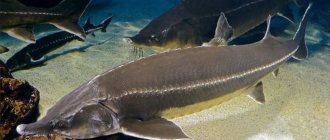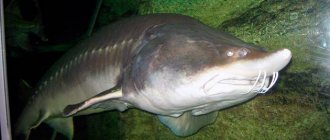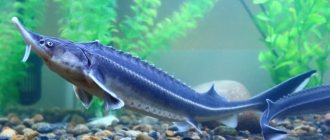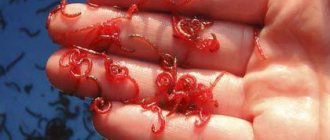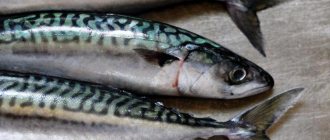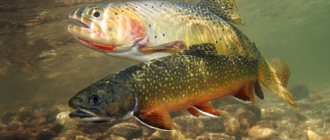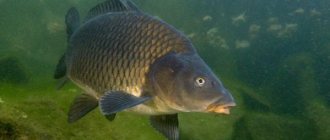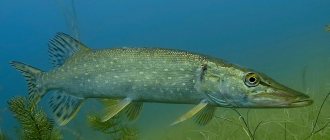The sturgeon family is considered a valuable fish species. According to scientists, the first generation appeared 80 million years ago - in the prehistoric period. Gradually, due to human activity, the population size is becoming smaller, so most fish belonging to the “sturgeon” family are strictly protected.
Sturgeon fish, of which there are more than 20 species, choose salty, sea waters for life, but prefer to spawn in fresh water. They also have a characteristic appearance - the body of all fish belonging to the “sturgeon” group is elongated, and the average weight of these inhabitants of the deep sea reaches 200 kg!
We present to your attention the top 10 largest sturgeons in the world.
Sterlet
Adult weight: 20 kg.
The presence of fringe on the antennae is what distinguishes the sterlet from its counterparts. In addition, she reaches puberty earlier than others. It prefers fresh water for life; it likes to feed on leeches, larvae, as well as invertebrates, and less often – fish fry.
As a rule, the size of an adult does not exceed 25 kg. Inhabits the Baltic, Black, Caspian and Azov Seas.
The sterlet differs in color depending on its habitat, but its main color can still be distinguished - it is a grayish back and a light yellowish belly. Sterlet can be blunt-nosed or sharp-nosed. It has characteristic long antennae, in addition, the fish has an interesting elongated nose, as you can see in the picture.
Thorn
This species of sturgeon is found mainly in the waters of the Aral and Caspian seas. Sometimes they are found in the Black and Azov Seas. In order to survive the frosty winters, they migrate to the Ural River.
The main difference between this species is the special structure of the lower lip. The body of the thorn has a gray-green tint, and the belly is colored light yellow. The entire body is covered with bone plates that play a protective function. Adults have a body length of 2 meters and a weight of 20 kg.
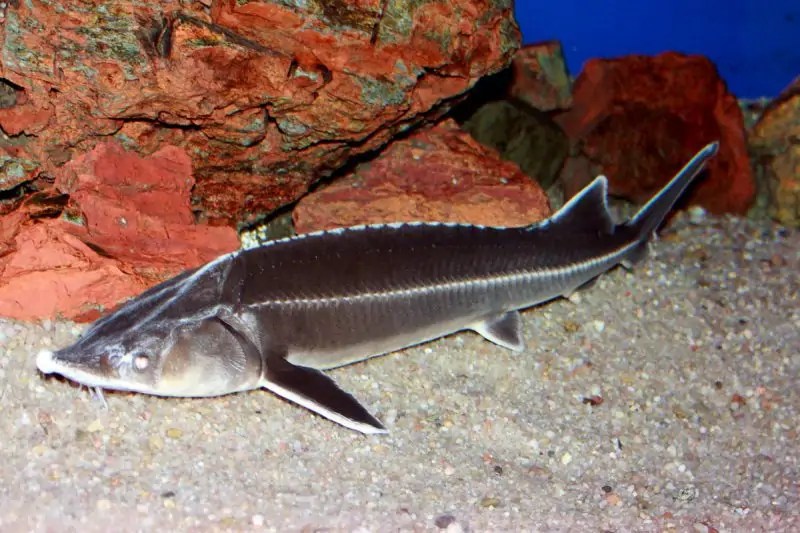
The thorn is inactive. While moving, it muddies the water with its fins. Representatives of this species perfectly adapt to life in any, even difficult, conditions and can stay in fresh waters for a long period of time, where they often interbreed with other sturgeons. Their average life expectancy is 20 years.
They reach sexual maturity at 12 years of age. At one time, the female lays about 1 million small eggs. They spawn in April.
White sturgeon
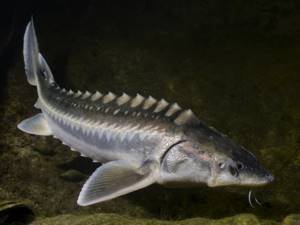
White (aka Californian) sturgeon has a slender and elongated shape. It has no scales, like all “sturgeon” fish. In amateur conditions, individuals up to 20 kg predominate, but larger specimens are also found.
California sturgeon prefers slow-moving rivers. White sturgeon is a bottom-dwelling fish; it feeds and lives at great depths. Uncontrolled fishing has led to the fact that the number of sturgeon in the central basins has decreased by 70%. The US and Canadian governments are taking measures to restore the sturgeon population.
Interesting Facts
There are many myths and legends associated with the beluga. For example, in ancient times, fishermen talked about the miraculous bilugin stone, which could heal a person from any disease, protect against troubles, preserve a ship from a storm and attract a good catch.
Fishermen believed that this stone could be found in the kidneys of a large beluga, and it was the size of a chicken egg - flat and oval in shape. The owner of such a stone could exchange it for a very expensive product, but it is still unclear whether such stones really existed, or whether craftsmen faked them. Even today, some anglers continue to believe this.
Another legend that at one time surrounded the beluga with an ominous aura is beluga poison. Some considered the liver of young fish or the meat of beluga, which could go crazy like a cat or dog, as poisonous, as a result of which its meat became poisonous. No evidence of this has yet been found.
Video
Russian sturgeon
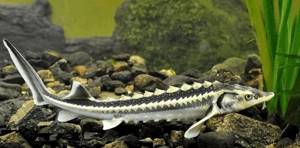
Adult weight: 25 kg.
Unfortunately, the Russian sturgeon is close to extinction. It lives in large rivers, for example, the Kuban and Volga (it also spawns there), as well as in the seas: the Caspian, Black and Azov.
Worms and crustaceans are food for the Russian sturgeon, and he never refuses to eat fish. His belly is light, his sides are gray, his back is the darkest part of his entire body.
In its natural habitat, a representative of the “sturgeon” can interbreed with sterlet or stellate sturgeon. It is easy to understand what species this fish belongs to; the sturgeon’s antennae grow not near the mouth, but near the nose; in addition, it happens that the weight of an adult individual reaches up to 120 kg.
Interesting fact: a huge sturgeon was once caught in the Volga - it reached 7 m 80 cm in length and weighed about 1440 kg!
Sturgeon species
The sturgeon family consists of about 25 species inhabiting waters of temperate latitudes in Europe, Asia and North America. Most of them are found in our reservoirs. These are semi-anadromous and freshwater fish, which are occasionally caught on the hooks of amateur fishermen.
The most famous sturgeon fish are:
- sturgeon (19 species included);
- beluga;
- sterlet;
- stellate sturgeon;
- Kaluga;
- thorn.
Sturgeon reach large sizes, so they prefer to live in spacious reservoirs with decent depths. To spawn, fish move upstream, entering tributaries and branches of rivers, reservoirs and seas.
Sturgeon fish is not like other underwater inhabitants that inhabit our water bodies. Its body is ridged, elongated, on which there are 5 rows of bone scutes. The snout is elongated, spade-shaped or conical, the mouth is small and toothless. As we can see, not a single roach or perch that is familiar to us can be confused with sterlet or stellate sturgeon.
Beluga
The largest fish of the sturgeon family. Anadromous, leads a bottom-pelagic lifestyle. Predator. Inhabits the Caspian, Azov and Black Seas, entering freshwater tributaries to spawn. Previously, it was considered a relatively widespread species, but today its reserves are extremely depleted, therefore the beluga is listed in the Red Book, and its fishing is prohibited.
For reference! Today, beluga is artificially crossed with sterlet. The resulting hybrid is called “bester”.
Beluga is ubiquitous in the Caspian Sea. It comes mainly to the Volga to spawn. It can rise quite high, up to the Volgograd hydroelectric complex. Also found in Kura, Ural and Terek, but in much smaller quantities.
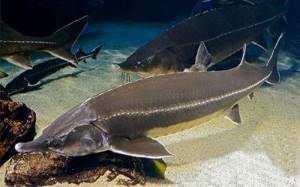
Beluga is the largest freshwater representative of the ichthyofauna
There is less of it in the Sea of Azov. It enters mainly the Don and rises to the Tsimlyansk Reservoir. The Black Sea population is distributed mainly in the northwestern part of the reservoir, spawning in the Danube, Dniester and Dnieper.
Adriatic sturgeon
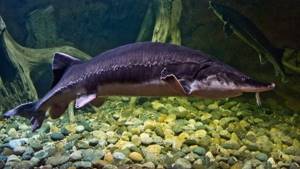
Adult weight: 25 kg.
The Adriatic sturgeon is a rare and little-studied species. At the moment, it is very rare in the Adriatic Sea basin, the species is probably almost extinct, and is therefore included in the IUCN Red List.
Government agencies are trying to restore the population. The Adriatic sturgeon was first described in 1836 by the French biologist Charles Lucien Bonaparte (1803-1857).
In the sea it lives at a depth of up to 40 m, sticking to the pre-estuary areas of rivers. The recorded maximum length of the Adriatic sturgeon was 200 cm and weight 25 kg. The diet of fish includes small fish and invertebrates.
Green sturgeon
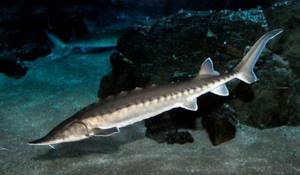
Adult weight: 25 kg.
Green sturgeon (also known as Pacific sturgeon) is one of the largest sturgeon fish in North America. By the age of 18, the sturgeon already weighs 25 kg. It is characterized by rapid growth, as well as a life expectancy of 60 years.
This species is little known to many; in addition, until recently scientists considered it extinct. It was indeed destroyed by civilization, but to please you, the sturgeon is alive and continues to fight!
In Russia, green sturgeon is common on Sakhalin, as well as in Primorye. Often found in the Datta River. Its snout is pointed and elongated. The back is usually olive in color, but there are individuals of a dark green color.
Siberian sturgeon
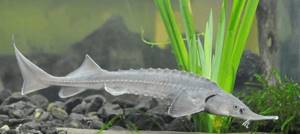
Adult weight: 34 kg.
The Siberian sturgeon is a long-lived fish; on average, it lives 50 years. Inhabits small and large Siberian rivers. It grows slowly, gradually gaining weight up to 25-35 kg.
The Siberian sturgeon, like other representatives of the sturgeon family, has characteristic antennae on its chin. The fish has a retractable mouth and no teeth. It is distinguished from other species of the family by its pointed head and gill rakers, which resemble a fan in shape.
It feeds on insects, larvae, and is also not averse to eating shellfish and fish. Leads a bottom-dwelling lifestyle. If a Siberian sturgeon is crossed with a sterlet, a hybrid will be born - a sterlet.
Amur sturgeon
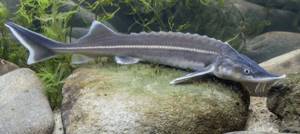
The Amur sturgeon (aka shrenka ) is a relative of the Siberian sturgeon. He was as unlucky as some other species of “sturgeon” - he is close to extinction and, of course, is listed in the Red Book.
It differs from other species in its gill membranes, small mouth, and also lacks plates between the bugs. Lives only in the Amur in the area from the mouth to the Argun. It begins to spawn at the age of 14.
The shrenk feeds on crustaceans, mayflies, fry and larvae. It happens that sturgeon reaches 80 kg. About half the body length is allocated for the snout. The Amur sturgeon prefers flowing and fast water.
Kaluga
Belongs to the sturgeon family. The body of the fish reaches 6 meters in length, weight - 1200 kg. It is found in the Amur basin, near Hokkaido, Kamchatka, and Sakhalin. Kaluga is the pride of Russia. Due to the rapid decline in numbers, it is listed in the Red Book. Environmental pollution and uncontrolled poaching are the main factors influencing the population decline.
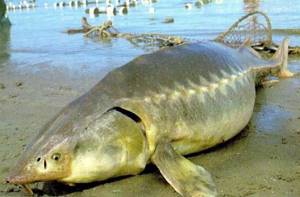
Giant Kaluga
The body of the kaluga is elongated, covered with bone plates in five rows with pointed spines. The triangular head is covered with thick leather. The mouth is large and transverse. At the bottom there are flattened antennae. The back and upper part of the head of the fish are green, the belly is white. In size, kaluga is second only to beluga. This colorful representative of the Far East is interesting to ichthyologists for its unique habits and behavior:
- Participate in spawning once every five years;
- Females are ready to breed at 17 years of age, laying up to 1.5 million eggs at a time;
- The adult feeds by sucking in prey. The fish opens its toothless mouth and draws in the victim along with the water like a pump;
- Kaluga is not picky about food. It feeds on bony, spiny fish covered in poisonous mucus.
Stellate sturgeon

Adult weight: 90 kg.
Sevruga is a close relative of the thorn and no less interesting fish - sterlet. Has an elongated body. It differs from other representatives of the sturgeon family in its snout - the head of the sturgeon is flattened to the tip. The snout makes up 70% of the length of the head. The back is dark brownish, almost black, while the sides are much lighter.
The weight of the largest individuals sometimes reaches 90 kg (the largest weight for the Danube). Stellate sturgeon is most common in the Black, Azov, and Caspian Seas. Lives approximately 30 years. The diet of stellate sturgeon includes worms, fry and a variety of crustaceans.
Chinese sturgeon
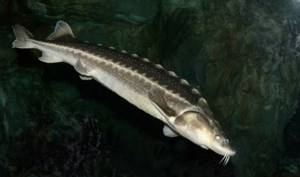
According to scientists, the Chinese sturgeon belongs to the “oldest” species, and existed on the planet about 140 million years ago. It lives in the coastal Chinese seas and is protected by the state due to the threat of extinction (for the capture of a Chinese sturgeon, a very serious punishment is imposed - imprisonment for up to 20 years).
Having reached sexual maturity, the sturgeon migrates to rivers. Most often found in the Pearl and Yangtze rivers. The Chinese sturgeon is one of the largest species of freshwater fish - their weight can reach 200, 500 kg.
Atlantic sturgeon
Representatives of this species of sturgeon are called giants, living in the seas and rivers of the European continent. In Russia they are found in the waters of the Baltic and White Seas. Weighing 180 kg, they grow up to 6 meters. The Atlantic sturgeon is capable of living in both salt and fresh water. To get food for themselves, they descend to great depths. They are helped in this by a special body structure and a large fin in the tail.
To live, Atlantic sturgeons choose deep-sea areas, where they eat bottom-dwelling mollusks and crustaceans. The average lifespan of fish is 100 years.
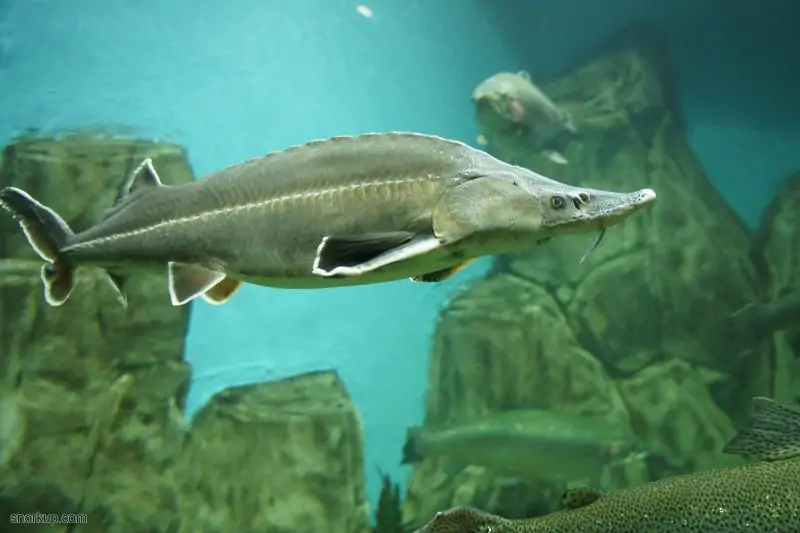
Males reach the age of sexual maturity at 11 years, and females at 18. For the purpose of reproduction, they rise to the surface once every few years to go upstream to sweep eggs, from which their fry appear 14-15 days later. And at 2 years old they begin their journey to the sea. However, along the way, many of them become food for other fish.
